Best Buy Bundle
How did Best Buy Become a Retail Giant?
Ever wondered how a small audio store transformed into a consumer electronics behemoth? The Best Buy SWOT Analysis reveals a fascinating journey of strategic pivots and market dominance. From its 1966 origins as Sound of Music, Best Buy's story is a testament to adaptability and innovation in a rapidly changing industry. Explore the evolution of this iconic brand and discover the key moments that shaped its success.
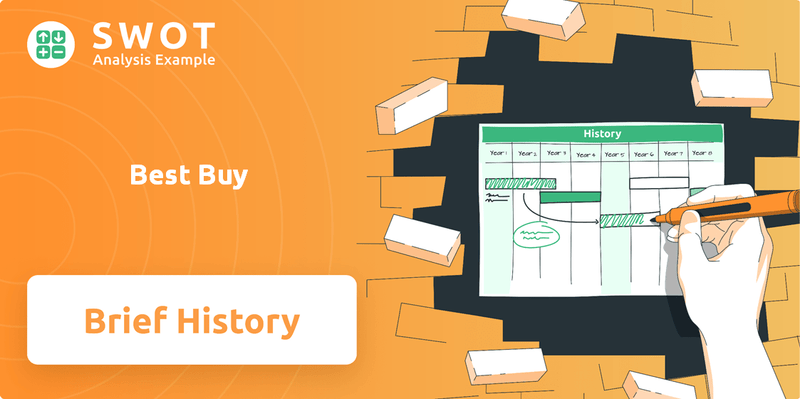
The brief history of Best Buy company reveals the early days of Best Buy, founded by Richard M. Schulze and James Wheeler, who started with a focus on audio components. Best Buy's company origin story is a compelling narrative of growth, marked by strategic Best Buy acquisitions and a commitment to meeting evolving consumer needs. Understanding the Best Buy timeline offers valuable insights into the company's transformation and its enduring impact on the consumer electronics landscape, from its first store location to its vast network of Best Buy stores today.
What is the Best Buy Founding Story?
The Best Buy history began on August 22, 1966, when Richard M. Schulze and James Wheeler founded the company. Initially named 'Sound of Music,' the business started as an audio specialty store in St. Paul, Minnesota. The early focus was on selling home and car stereo equipment, setting the stage for its future in consumer electronics.
The company's origin story is marked by a pivotal moment that shaped its business model. A key event occurred in 1981 when a tornado struck one of their stores. This led to the 'Tornado Sale,' where salvaged items were sold at significantly reduced prices, demonstrating the effectiveness of a high-volume, low-price strategy. This event was a turning point.
By 1982, 'Sound of Music' had achieved revenues of $9.3 million. The company officially transitioned to Best Buy Co., Inc. in 1983, signaling a strategic shift towards a superstore format. This format emphasized low prices and a wide selection of products, moving away from a commission-based sales approach.
The early days of Best Buy were crucial in shaping its future in the retail landscape. The company's evolution reflects its adaptability and strategic vision.
- Founded in 1966 as 'Sound of Music' by Richard M. Schulze and James Wheeler.
- 1981: The 'Tornado Sale' influenced the shift towards a high-volume, low-price model.
- 1982: Revenues reached $9.3 million under the 'Sound of Music' name.
- 1983: The company officially changed its name to Best Buy Co., Inc., adopting a superstore format.
The company's early success and transformation set the stage for its growth. Understanding the Best Buy company evolution provides insights into its long-term strategies. For more context, see the Competitors Landscape of Best Buy.
Best Buy SWOT Analysis
- Complete SWOT Breakdown
- Fully Customizable
- Editable in Excel & Word
- Professional Formatting
- Investor-Ready Format
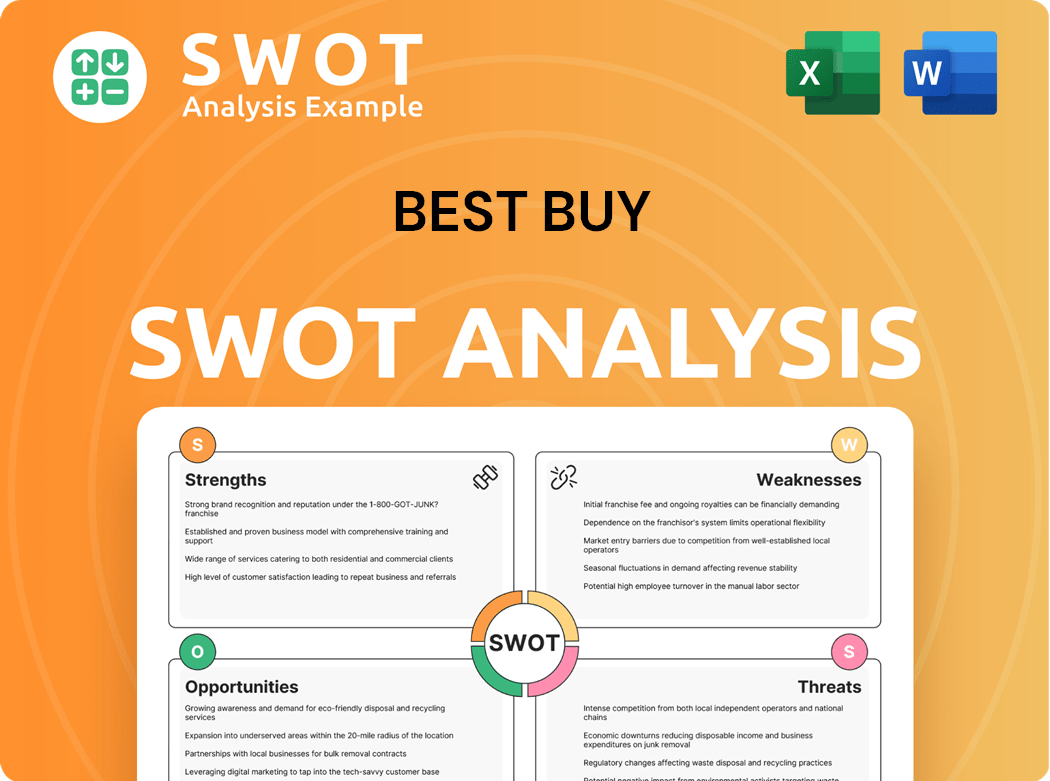
What Drove the Early Growth of Best Buy?
Following its 1983 rebranding, the Best Buy company experienced significant growth. This period marked a crucial phase in the Best Buy timeline, with the introduction of innovative store formats and strategic market entries. The company's expansion included both physical stores and its early steps into online retail, shaping its position in the consumer electronics market.
In 1984, Best Buy stores began operating in six states across the upper Midwest. The company broadened its product line beyond audio equipment. The 'superstore format' launched in Burnsville, Minnesota, in 1983, proved highly successful.
Best Buy went public in 1985, raising $8 million in its initial public offering on the Nasdaq. By 1987, the company was listed on the New York Stock Exchange, with revenues reaching $239 million from 24 stores. The introduction of 'Concept II' stores in 1989, featuring a warehouse format, further solidified their low-price model.
The 1990s saw continued product innovation and numerous store openings. Revenues surpassed $1 billion in 1993, reaching $1.6 billion. In 2000, Best Buy relaunched an expanded bestbuy.com website, marking its entry into online retailing.
A major milestone in international expansion occurred in 2001 with the acquisition of Future Shop Ltd. This acquisition was the biggest in Best Buy's history and its first step into the international market. The company also integrated the Geek Squad. To understand the company's core values, consider reading this article about Mission, Vision & Core Values of Best Buy.
Best Buy PESTLE Analysis
- Covers All 6 PESTLE Categories
- No Research Needed – Save Hours of Work
- Built by Experts, Trusted by Consultants
- Instant Download, Ready to Use
- 100% Editable, Fully Customizable
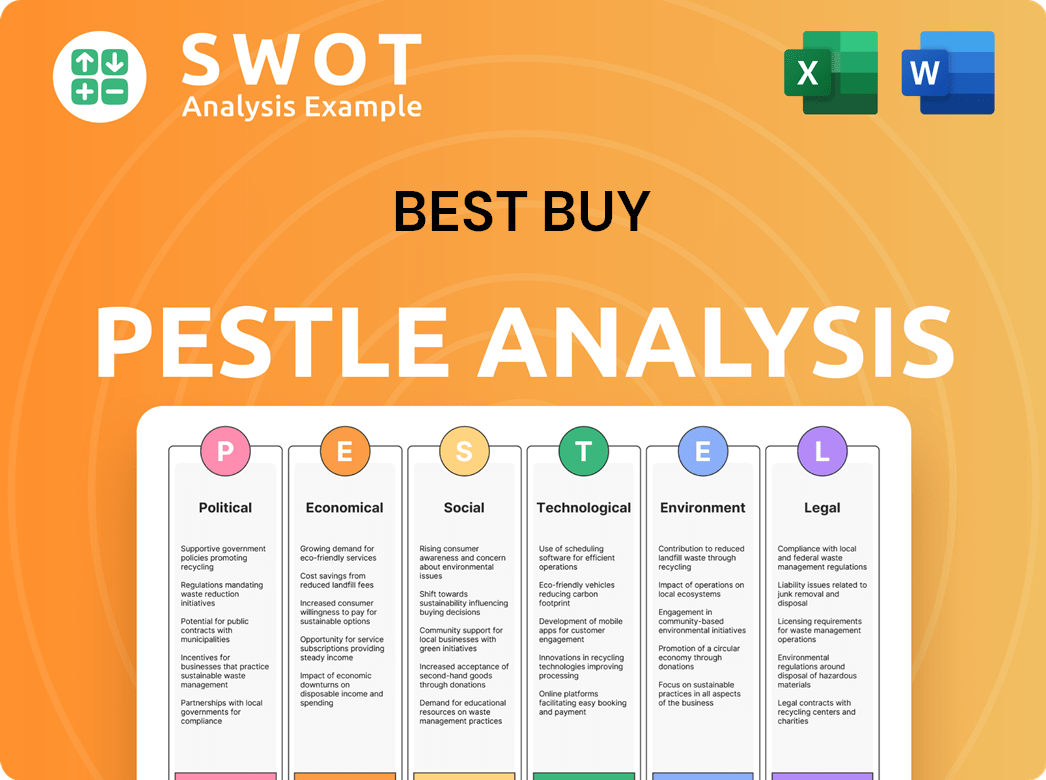
What are the key Milestones in Best Buy history?
The Best Buy company has a rich history marked by significant milestones, from its early days to its current standing as a major retailer. These achievements have shaped the company’s trajectory and its influence on the consumer electronics market.
| Year | Milestone |
|---|---|
| 1966 | The company was founded by Richard M. Schulze and James Wheeler in St. Paul, Minnesota, originally as Sound of Music. |
| 1983 | The company transitioned to the superstore format, a significant shift in its retail strategy. |
| 1989 | Elimination of sales commissions, focusing on competitive pricing and a more relaxed shopping environment. |
| 2000 | Acquisition of Magnolia Hi-Fi, expanding into the high-end consumer electronics market. |
| 2001 | Entry into the international market with the acquisition of Future Shop Ltd. in Canada. |
| 2002 | Acquisition of Geek Squad, integrating technical support services into its offerings, and Musicland Stores Corporation. |
| 2012 | Initiation of the 'Renew Blue' turnaround initiative, a strategic move to revitalize the business. |
| 2021 | Layoffs of over 5,000 employees and shift to part-time roles, despite increased demand for computer equipment. |
| 2026 | Restructuring of the health business, with $109 million in charges, indicating a strategic shift. |
Innovations have been central to the evolution of the
The adoption of the superstore format in 1983 revolutionized the way consumers shopped for electronics. This format provided more space for product displays and a wider selection of items, enhancing the overall shopping experience.
The decision to eliminate sales commissions in 1989 was a strategic move to create a more customer-friendly environment. This change shifted the focus from aggressive selling to providing helpful advice and competitive pricing.
The introduction of 'Blue Shirt' employees, known for their product knowledge and customer service, became a hallmark of the brand. These employees were trained to assist customers, making informed decisions.
The development of a robust omnichannel model, integrating physical stores with a strong digital platform, was a key innovation. This approach allowed customers to shop seamlessly across different channels.
Diversifying services, particularly through Geek Squad and Best Buy Health, allowed the company to enhance customer engagement and explore new revenue streams. These services expanded the company's offerings beyond product sales.
Optimizing the real estate footprint by closing large-format stores and opening smaller, tailored formats was a strategic adjustment. This approach aimed to improve operational efficiency and adapt to changing consumer behaviors.
Despite its successes, the
The rise of online retailers, especially Amazon, posed a significant threat to brick-and-mortar sales. This competition forced the company to rethink its strategies and focus on its online presence.
The company experienced revenue declines, with fiscal year 2024 reporting $43.452 billion, a 6.15% decrease from 2023, and fiscal year 2025 revenue at $41.528 billion, a 4.43% decrease from 2024. These declines underscored the need for strategic adjustments.
The 'Renew Blue' initiative in 2012 and the restructuring of the health business in fiscal year 2026, which led to $109 million in charges, highlighted the need for internal adjustments. These changes were aimed at revitalizing the business and adapting to market shifts.
The company faced the challenge of adapting to increased demand for computer equipment during the COVID-19 pandemic, while also laying off employees. This situation required strategic workforce adjustments.
Evolving consumer behaviors, including a shift towards online shopping and different service expectations, presented ongoing challenges. The company needed to adapt its offerings and customer service to meet these changing needs.
Maintaining operational efficiency while optimizing the real estate footprint and managing costs was a key challenge. The company aimed to balance its physical and digital presence to maximize profitability.
Best Buy Business Model Canvas
- Complete 9-Block Business Model Canvas
- Effortlessly Communicate Your Business Strategy
- Investor-Ready BMC Format
- 100% Editable and Customizable
- Clear and Structured Layout
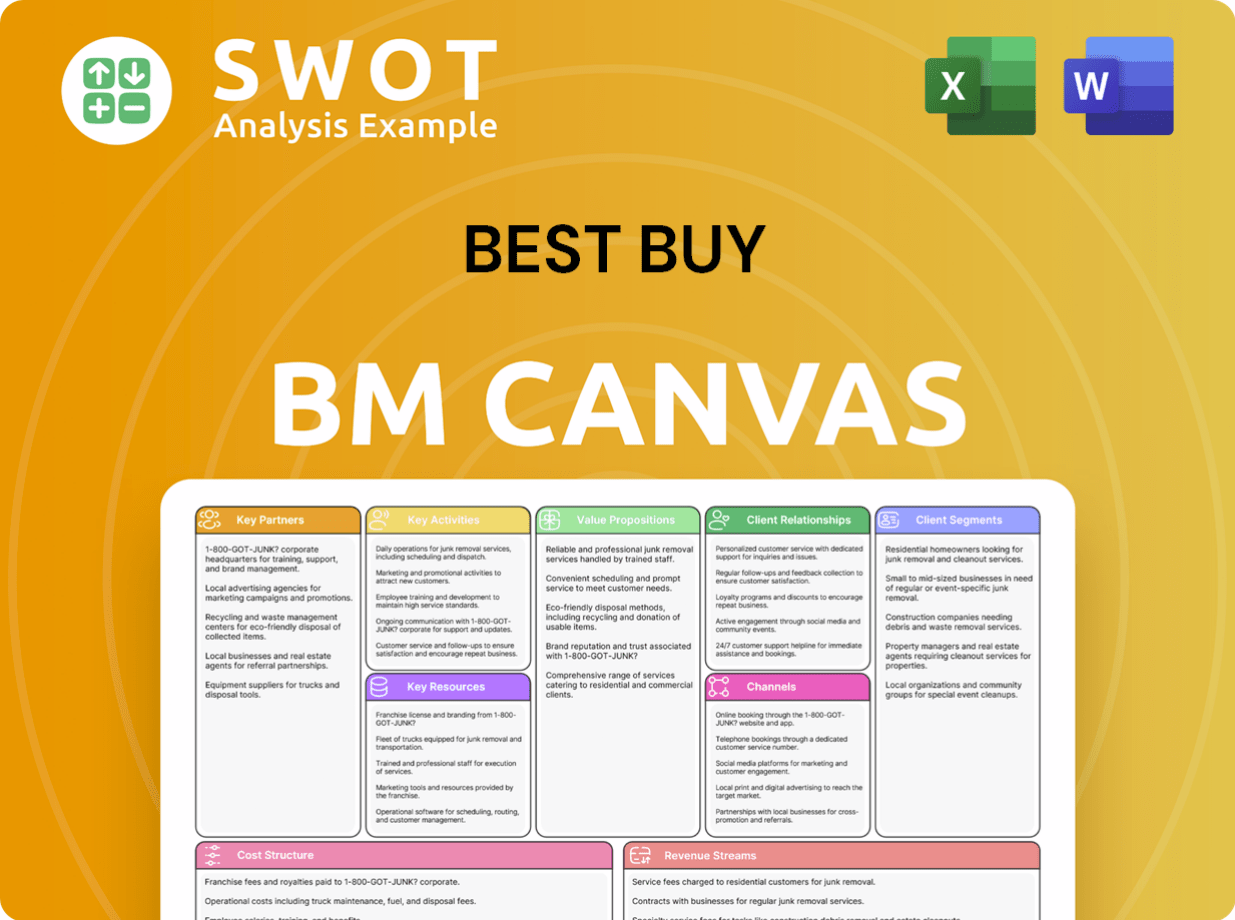
What is the Timeline of Key Events for Best Buy?
The story of the Best Buy company is a journey of innovation and adaptation in the consumer electronics market. From its humble beginnings as a small audio store to its current status as a major retailer, Best Buy's history is marked by strategic shifts and significant milestones. This Best Buy timeline showcases the key events that have shaped the company.
| Year | Key Event |
|---|---|
| 1966 | Richard M. Schulze and James Wheeler open Sound of Music in St. Paul, Minnesota, marking the beginning of the company. |
| 1981 | The 'Tornado Sale' inspires a new low-price, high-volume business model, a pivotal moment for the company. |
| 1983 | Sound of Music is renamed Best Buy Co., Inc., and the first superstore opens, representing a major shift in strategy. |
| 1985 | Best Buy goes public on the Nasdaq, a significant step in its growth. |
| 1989 | Introduction of 'Concept II' stores with a non-commissioned, warehouse-style format, changing the retail experience. |
| 1993 | Revenues surpass $1 billion, highlighting the company's financial success. |
| 2000 | Bestbuy.com is launched, marking its entry into online retail. |
| 2001 | Acquisition of Future Shop Ltd., expanding its presence into Canada. |
| 2002 | Acquisition of Geek Squad, enhancing its service offerings. |
| 2012 | 'Renew Blue' turnaround strategy is initiated, focusing on transformation. |
| 2020 | Best Buy exits the Mexican market due to the COVID-19 pandemic, reflecting the impact of global events. |
| 2021 | Best Buy lays off over 5,000 employees, indicating a period of restructuring. |
| 2024 | Best Buy's fiscal year revenue is $43.452 billion, demonstrating its substantial market presence. |
| 2025 | Best Buy's fiscal year revenue is $41.528 billion, with 1,117 stores globally, reflecting current performance. |
Best Buy is concentrating on its omnichannel approach, merging physical stores and online platforms. This strategy aims to offer customers a seamless shopping experience, catering to changing consumer behaviors. The company is focused on integrating its online presence with its physical store locations.
The company is growing its service offerings, particularly through Best Buy Health. This expansion is a key component of Best Buy's strategy to provide comprehensive solutions. The move reflects a broader trend toward offering value-added services.
In fiscal year 2026, Best Buy plans to reduce its Domestic store count by approximately 5 to 10 stores as part of its real estate optimization strategy. This strategic move is aimed at improving operational efficiency. Capital expenditures are anticipated to be between $700 million and $750 million.
Analyst predictions for fiscal year 2026 project an increase in diluted EPS to $6.64, up 7.4% year-over-year from fiscal 2025's expected $6.18. The company is also continuing its commitment to operational efficiency to fund new initiatives and offset financial pressures. Managing the uncertainty of tariffs is also a key focus.
Best Buy Porter's Five Forces Analysis
- Covers All 5 Competitive Forces in Detail
- Structured for Consultants, Students, and Founders
- 100% Editable in Microsoft Word & Excel
- Instant Digital Download – Use Immediately
- Compatible with Mac & PC – Fully Unlocked
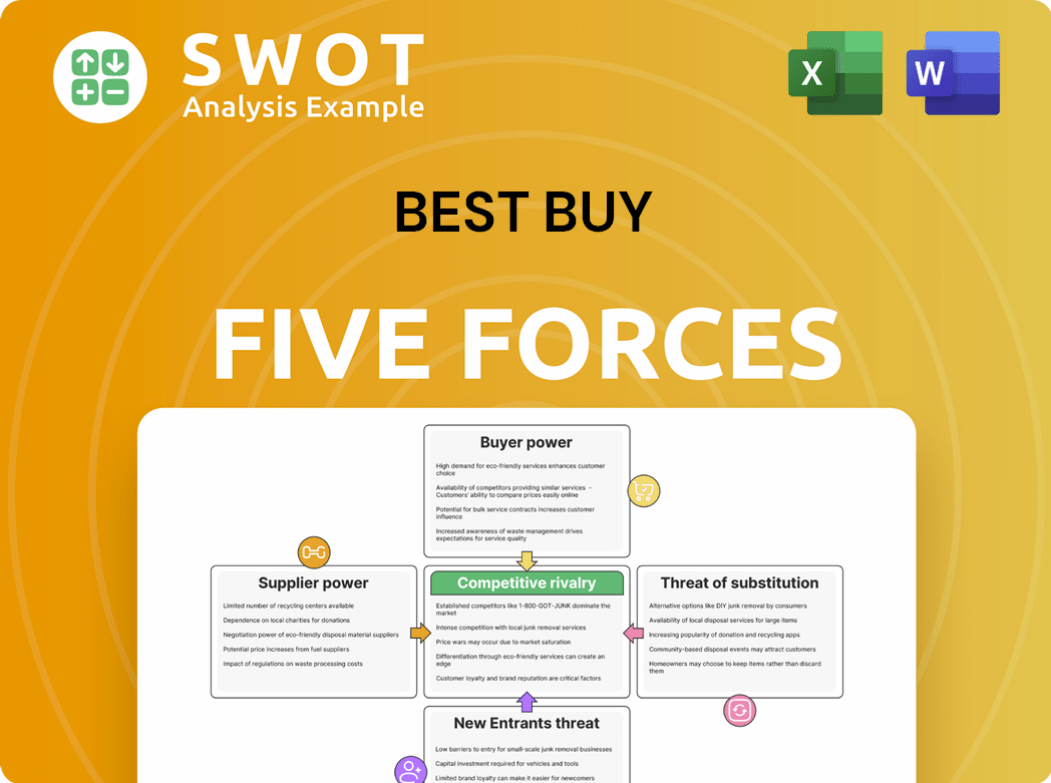
Related Blogs
- What is Competitive Landscape of Best Buy Company?
- What is Growth Strategy and Future Prospects of Best Buy Company?
- How Does Best Buy Company Work?
- What is Sales and Marketing Strategy of Best Buy Company?
- What is Brief History of Best Buy Company?
- Who Owns Best Buy Company?
- What is Customer Demographics and Target Market of Best Buy Company?
Disclaimer
All information, articles, and product details provided on this website are for general informational and educational purposes only. We do not claim any ownership over, nor do we intend to infringe upon, any trademarks, copyrights, logos, brand names, or other intellectual property mentioned or depicted on this site. Such intellectual property remains the property of its respective owners, and any references here are made solely for identification or informational purposes, without implying any affiliation, endorsement, or partnership.
We make no representations or warranties, express or implied, regarding the accuracy, completeness, or suitability of any content or products presented. Nothing on this website should be construed as legal, tax, investment, financial, medical, or other professional advice. In addition, no part of this site—including articles or product references—constitutes a solicitation, recommendation, endorsement, advertisement, or offer to buy or sell any securities, franchises, or other financial instruments, particularly in jurisdictions where such activity would be unlawful.
All content is of a general nature and may not address the specific circumstances of any individual or entity. It is not a substitute for professional advice or services. Any actions you take based on the information provided here are strictly at your own risk. You accept full responsibility for any decisions or outcomes arising from your use of this website and agree to release us from any liability in connection with your use of, or reliance upon, the content or products found herein.